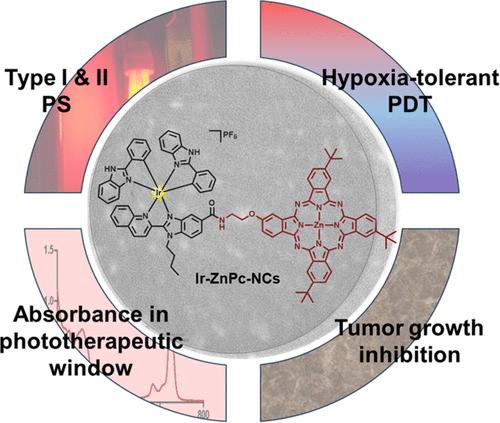当前位置:
X-MOL 学术
›
ACS Appl. Mater. Interfaces
›
论文详情
Our official English website, www.x-mol.net, welcomes your
feedback! (Note: you will need to create a separate account there.)
A Nanoencapsulated Ir(III)-Phthalocyanine Conjugate as a Promising Photodynamic Therapy Anticancer Agent
ACS Applied Materials & Interfaces ( IF 8.3 ) Pub Date : 2024-07-23 , DOI: 10.1021/acsami.4c05181 Joaquín Bonelli 1, 2 , Enrique Ortega-Forte 3 , Gloria Vigueras 3 , Jorge Follana-Berná 4 , Pezhman Ashoo 3 , Diego Abad-Montero 1 , Neus Isidro 2 , Marta López-Corrales 1 , Adrián Hernández 4 , Javier Ortiz 4 , Eduardo Izquierdo-García 1 , Manel Bosch 5 , Josep Rocas 2 , Ángela Sastre-Santos 4 , José Ruiz 3 , Vicente Marchán 1
ACS Applied Materials & Interfaces ( IF 8.3 ) Pub Date : 2024-07-23 , DOI: 10.1021/acsami.4c05181 Joaquín Bonelli 1, 2 , Enrique Ortega-Forte 3 , Gloria Vigueras 3 , Jorge Follana-Berná 4 , Pezhman Ashoo 3 , Diego Abad-Montero 1 , Neus Isidro 2 , Marta López-Corrales 1 , Adrián Hernández 4 , Javier Ortiz 4 , Eduardo Izquierdo-García 1 , Manel Bosch 5 , Josep Rocas 2 , Ángela Sastre-Santos 4 , José Ruiz 3 , Vicente Marchán 1
Affiliation

|
Despite the potential of photodynamic therapy (PDT) in cancer treatment, the development of efficient and photostable photosensitizing molecules that operate at long wavelengths of light has become a major hurdle. Here, we report for the first time an Ir(III)-phthalocyanine conjugate (Ir-ZnPc) as a novel photosensitizer for high-efficiency synergistic PDT treatment that takes advantage of the long-wavelength excitation and near infrared (NIR) emission of the phthalocyanine scaffold and the known photostability and high phototoxicity of cyclometalated Ir(III) complexes. In order to increase water solubility and cell membrane permeability, the conjugate and parent zinc phthalocyanine (ZnPc) were encapsulated in amphoteric redox-responsive polyurethane-polyurea hybrid nanocapsules (Ir-ZnPc-NCs and ZnPc-NCs, respectively). Photobiological evaluations revealed that the encapsulated Ir-ZnPc conjugate achieved high photocytotoxicity in both normoxic and hypoxic conditions under 630 nm light irradiation, which can be attributed to dual Type I and Type II reactive oxygen species (ROS) photogeneration. Interestingly, PDT treatments with Ir-ZnPc-NCs and ZnPc-NCs significantly inhibited the growth of three-dimensional (3D) multicellular tumor spheroids. Overall, the nanoencapsulation of Zn phthalocyanines conjugated to cyclometalated Ir(III) complexes provides a new strategy for obtaining photostable and biocompatible red-light-activated nano-PDT agents with efficient performance under challenging hypoxic environments, thus offering new therapeutic opportunities for cancer treatment.
中文翻译:

纳米封装的 Ir(III)-酞菁缀合物作为有前途的光动力治疗抗癌剂
尽管光动力疗法(PDT)在癌症治疗中具有潜力,但开发在长波长光下起作用的高效且光稳定的光敏分子已成为主要障碍。在这里,我们首次报道了 Ir(III)-酞菁结合物( Ir-ZnPc )作为一种新型光敏剂,利用 Ir(III)-酞菁结合物的长波长激发和近红外 (NIR) 发射,用于高效协同 PDT 治疗。酞菁支架和已知的环金属化 Ir(III) 配合物的光稳定性和高光毒性。为了增加水溶性和细胞膜渗透性,将缀合物和母体锌酞菁( ZnPc )封装在两性氧化还原响应性聚氨酯-聚脲杂化纳米胶囊(分别为Ir-ZnPc-NCs和ZnPc-NCs )中。光生物学评估表明,封装的Ir-ZnPc缀合物在 630 nm 光照射下在常氧和缺氧条件下均实现了高光细胞毒性,这可归因于 I 型和 II 型活性氧 (ROS) 双重光生作用。有趣的是,使用Ir-ZnPc-NC和ZnPc-NC进行 PDT 治疗可显着抑制三维 (3D) 多细胞肿瘤球体的生长。总体而言,锌酞菁与环金属化Ir(III)配合物的纳米封装为获得光稳定且生物相容的红光激活纳米PDT制剂提供了一种新策略,该纳米PDT制剂在具有挑战性的低氧环境下具有高效的性能,从而为癌症治疗提供了新的治疗机会。
更新日期:2024-07-23
中文翻译:

纳米封装的 Ir(III)-酞菁缀合物作为有前途的光动力治疗抗癌剂
尽管光动力疗法(PDT)在癌症治疗中具有潜力,但开发在长波长光下起作用的高效且光稳定的光敏分子已成为主要障碍。在这里,我们首次报道了 Ir(III)-酞菁结合物( Ir-ZnPc )作为一种新型光敏剂,利用 Ir(III)-酞菁结合物的长波长激发和近红外 (NIR) 发射,用于高效协同 PDT 治疗。酞菁支架和已知的环金属化 Ir(III) 配合物的光稳定性和高光毒性。为了增加水溶性和细胞膜渗透性,将缀合物和母体锌酞菁( ZnPc )封装在两性氧化还原响应性聚氨酯-聚脲杂化纳米胶囊(分别为Ir-ZnPc-NCs和ZnPc-NCs )中。光生物学评估表明,封装的Ir-ZnPc缀合物在 630 nm 光照射下在常氧和缺氧条件下均实现了高光细胞毒性,这可归因于 I 型和 II 型活性氧 (ROS) 双重光生作用。有趣的是,使用Ir-ZnPc-NC和ZnPc-NC进行 PDT 治疗可显着抑制三维 (3D) 多细胞肿瘤球体的生长。总体而言,锌酞菁与环金属化Ir(III)配合物的纳米封装为获得光稳定且生物相容的红光激活纳米PDT制剂提供了一种新策略,该纳米PDT制剂在具有挑战性的低氧环境下具有高效的性能,从而为癌症治疗提供了新的治疗机会。











































 京公网安备 11010802027423号
京公网安备 11010802027423号